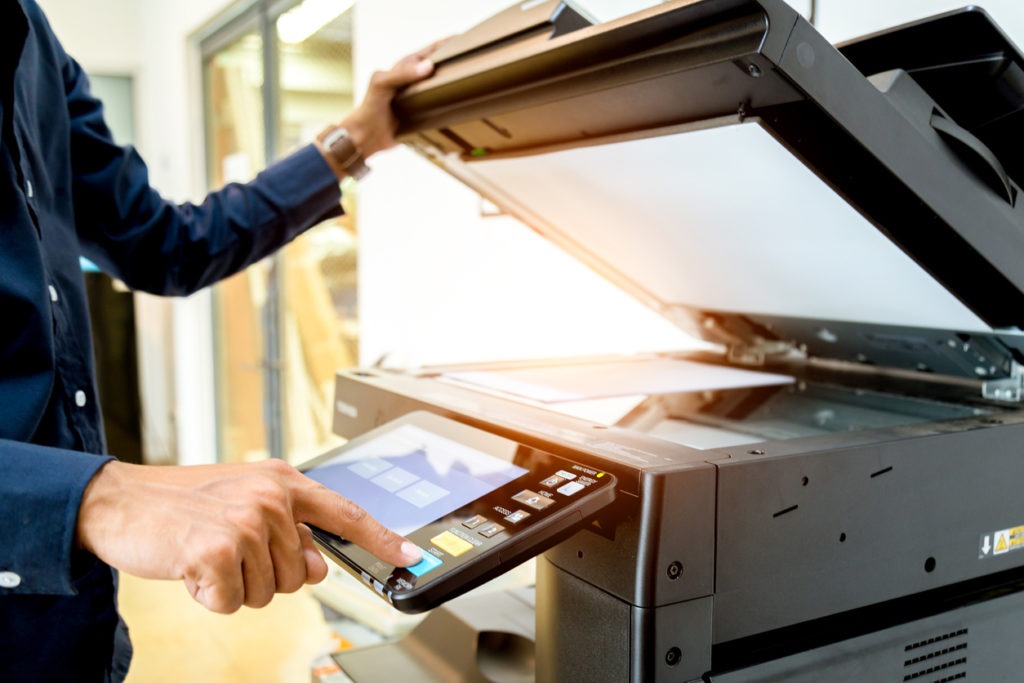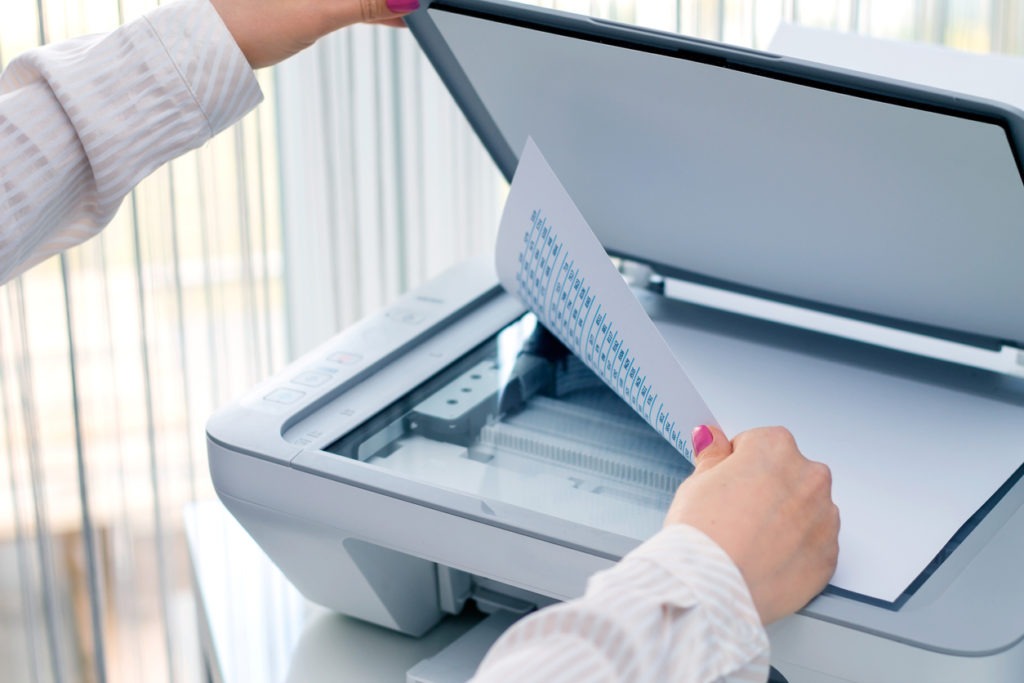A scanner is a device that is a must-have in any home office. It is beneficial as it allows you to digitize your files so that they can remain safe and saved on your computer or online. When working from home, you often need to send soft copies of documents that you have in hard-copy format. You can always take a picture, but scanning is much more professional and lets you clearly capture everything on the paper.
The widespread use of technology and business going paperless has increased the demand for document scanners. Additionally, when you work from home, scanning the document and sending it to your boss or client is much more convenient than driving over or posting it. Digital files are also much more secure and ensure that essential documents are not lost.
What Is a Document Scanner?
A document scanner is a device that allows you to convert your documents into a digital format. These scanners are necessary for most offices, and if you have a home office, you should also invest in one. The reason for their popularity is the increased use of the internet and the need for most organizations to have a digital copy of every document.
Most companies and individuals are moving towards digitizing their files for safekeeping. Document scanners are essential in making that possible. For such an important task, you must purchase an efficient scanner that fulfills all your needs.
Why Do You Need a Document Scanner for Your Home Office?
A document scanner is essential in most people’s offices because digital safekeeping and document storage has various benefits. Here are a few benefits you can reap from having a document scanner in your home office.
It Helps Save Time
Having a scanner saves a lot of time because when you manually file your documents, you need to search through them to find the one you need. On the other hand, when you modify your filing system to be digital, you can find it by simply searching for the relevant keywords. This means that your documents are readily available, and you can access them even if you are not at home.
With all your information and documents readily available, you can be much more productive as you do not need to get up to retrieve documents physically. You can do everything you want from the comfort of your seat. Less time spent searching for your documents also prevents you from getting distracted, so you can stay focused on your task.
It Keeps Your Documents Secure
When your filing system is digital, you can keep your sensitive information safe and prevent it from getting into the wrong hands. Physical documents are much easier to alter and remove. If someone steals a document from your cabinet, chances are that you wouldn’t even notice until you go to retrieve it. On the other hand, you can sign your digital documents with an encrypted digital signature, which will help protect them from being manipulated.
Additionally, most online clouds and drives can be password-protected, providing even more security.
Your Documents Do Not Get Damaged
Paper documents are fragile and can easily be lost or destroyed by water, fire, or a natural disaster. Digital files are much easier to protect as you can back them up and save them on a cloud service. That way, not only are they safe, but you can also access them from anywhere. If you go on a trip, all you need is your laptop. This makes it much more convenient to work from home because you do not need to worry about losing a file or forgetting to take it if you plan to go on a trip.
You Can Collaborate with Your Team Members
A document scanner allows you to collaborate with your team members more easily. Since you can scan and upload pretty much any document, you can invite your team members to edit it remotely. There is no need to send a document back and forth. Digitizing your file using a document scanner also makes real-time collaboration possible.
Documents Are Much Easier to Share
If your job requires you to send documents to others regularly, having a document scanner in your home office is highly beneficial. It simplifies the process of sharing a document, as you just need to scan and send it. It also saves you money from having to mail it physically. Mailing it also comes with risks, as the document can get damaged or lost.
Types of Scanners
Flatbed Scanners
Flatbed scanners are the most popular type. These are the scanners that reveal their scanning glass as you open the flip-up lid. Furthermore, flatbed scanners are mostly designed for scanning books, articles, newspapers, etc. In addition to that, flatbed scanners can scan photos as well, provided that you opt for a high-resolution one. However, this type is slow as compared to the rest. Scanning a document takes time, and therefore, bulk scanning is not recommended.
Photo Scanners
Photos scanners are exactly what the title suggests. These scanners are designed to scan a large volume of photographs and negatives. Depending on the resolution and color depth, these scanners can be expensive. If you are a professional photographer or editor, then purchasing a photo scanner is going to be a worthy investment. However, if you intend to purchase one for general purposes, then opt for a scanner that does not feature extremely high color resolution.
Multi-function Scanner Printer Copier
Today, multifunction printers are in more demand than any other type. The reason is that multifunction printers are able to print, scan, and copy at the same time. With everything under one roof, there is no need to spend on an individual scanner or a printer. If you are someone who works from home and is tight on space, then a multifunction printer is going to be the best option. It will not only save you space but provide every document-related function with just a click of a button.
Portable Scanners
Portable scanners are designed to be lightweight and easy to carry. This allows them to be transported and used almost anywhere, anytime. The size of portable scanners depends on quality. The higher the quality, the larger the size will be. Although portable scanners will not offer as high quality as flatbed scanners but they do have a place in the world of scanners.
Factors To Consider When Purchasing a Document Scanner
When purchasing a document scanner, you must buy a high-quality one because it gives you a clear image of the document. The better your document scanner is, the clearer the images and words on the paper will be. There are a lot of factors that you should take into account when buying a scanner because you will most likely be using it frequently. Here are a few factors you should take into consideration.
Performance
The performance of a scanner is a crucial factor to take into account. When comparing the performances of document scanners, consider the number of documents you expect to scan. If you anticipate scanning multiple documents daily, the scanner should ideally be speedy and scan the document in a shorter span.
Generally, many factors play a role in the speed of a scanner. If your scanner has a higher resolution or color depth, it will likely take more time to scan the document. You can measure the speed of a scanner in multiple ways. Firstly you can assess the time taken to scan a single document. Secondly, the number of pages it can scan per minute. Thirdly, the number of images it can scan per minute.
Size and Noise
When purchasing a scanner for your home office, you must consider the overall size of it and the amount of noise it will make. There are various sizes of scanners available on the market, which is why considering the size is extremely important.
You can find handheld roller-type area scanners as well as those that can stand on their own. The handheld kind takes next to no space, while the latter takes up a lot of space and creates a lot of noise. When setting up your home office, assess the area you have. If you have a lot of space and can afford to set up a large scanner, you should opt for a larger scanner that will most likely be much more powerful.
Portable scanners are much more travel-friendly and provide medium-level speed, which is perfect if you don’t have to do a lot of scanning. One disadvantage of these scanners is that you need to feed the paper in a very particular alignment. Otherwise, the image will be skewed.
In terms of noise, larger scanners are much noisier. If you prefer to work in silence, you should choose one that is either smaller or designed to be silent. You can find out how much noise a scanner makes by checking the product description.
Pricing
The price of the document scanner you are purchasing is also an important consideration. The cost usually depends on several factors, including the print speed and the scanner’s size. Portable document scanners are a much better option if you are on a budget. For around $60, you can easily get a useful and efficient handheld scanner. On the other hand, if you work with a large number of documents, you should opt for a larger scanner. These can cost you up to $200.
Does It Support Thick Paper or Odd-Sized Documents?
You won’t always need to scan regular sheets of paper when working from home. Some companies also require their employees to scan business cards, which are thicker than standard paper. Ensure that your scanner can scan thicker sheets of paper to avoid any issues.
Additionally, some scanners allow you to scan very thick documents at once using their straight-through roller system, while others use specialized ADF scanning. Depending on your use, you should choose one of these.
Resolution
The resolution of your scanner is one of the easiest ways to disguise a good scanner from a bad one. Resolution is the number of pixels the scanner can capture and is usually measured in dots per inch or dpi. The higher the scanner’s resolution, the more information it can capture and the better the image quality will be. If your image is of low quality, your scanner must have a high dpi to capture everything accurately.
Scanners with a high resolution can produce accurate images of your documents, even at a resolution lower than their maximum. Scanners usually come with one of two types of resolutions: optical and interpolated. Due to all these options, you should choose your scanner based on what you intend to scan. For example, suppose you work with a lot of images that you want to turn digital. In that case, your scanner must be able to scan it with all its intricacies.
If you purchase a scanner for your home office, one with 600 dpi should work well and produce both high-quality and regular photo scans. If the documents you want to scan are more demanding graphic and photo scans, you should opt for a scanner with a resolution of 1200 dpi or more.
Color/Bit Depth
The bit depth of a scanner is the amount of information it can record per pixel. The higher the bit depth, the more colors a scanner can record, resulting in a higher-quality image. Higher bit rates also result in larger file sizes because the scanner is essentially picking up more information per pixel, which needs to be stored.
If you work with a lot of images, you should purchase a scanner that has a higher bit rate. Under normal circumstances, 24 bits is enough, but a scanner with 36-bit depth would be much better for pictures and images.
Dynamic Range
The dynamic range of a scanner is also the optical density (OD) or density range, which measures the scanner’s ability to capture multiple hues in the image it is capturing. Dynamic range is measured on a scale of 0 to 4, where 0.0 represents a perfect white, while 4.0 represents a perfect black.
Dynamic range is the difference between the lightest and darkest hue that a scanner can capture. Therefore, the larger the difference, the better the image quality of the scanner. When purchasing a scanner, ensure that it has a large dynamic range to capture high-quality scans.
Pros and Cons of Document Scanners
| Pros | Cons |
| Allow quick preservation of documents. | They can only scan one side at a time. |
| Digitalization allows you to save your documents more safely. | The texts and graphics are usually of lower quality. |
| Allows you to share documents with ease. |
FAQs
What should I look for in a document scanner for my home office?
When purchasing a scanner for your home office, consider the space you have, what dpi you require, the resolution of the scanner, and your budget.
What are the three most common kinds of scanners?
The most common kinds of scanners include drum scanners, flatbed scanners, and handheld scanners.
How long should a scanner last?
A scanner usually has a lifespan of around 500,000 scans. However, if you take good care of it, you can make it last even longer.
Conclusion
When setting up a home office, you must purchase many devices, such as paper shredders, printers, and document scanners. Document scanners are handy devices as they make storing and retrieving important data much easier. Using scanners and home office printers together allows you to make hard copies of your documents, which can help boost productivity. You can also access your files from anywhere, eliminating the worry of forgetting or losing important files.
To ensure that the digitization process goes smoothly, the document scanner you purchase must be up to the mark. Always consider factors such as the resolution, size, price, dynamic range, and color depth to ensure you are purchasing a scanner that fits your needs.
If it is your first time to setup a home office, our article about Under-the-Stairs Home Office Setup might provide you with some useful tips and recommendations.



